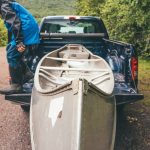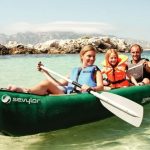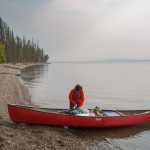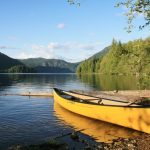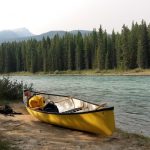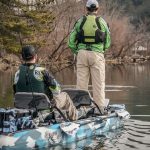Aluminum canoes are quite popular because they will last for generations. Here is our list of the best aluminum canoes available on the market today.

For most paddlers, heading out in a canoe means loading up with a partner and paddling in tandem. The canoe is a sociable way to hit the water, with enough space and capacity for two adults to get comfortable and load up with gear for fishing, tripping, or just to enjoy a cooler full of drinks.
Sure, there are solo canoes that are great if you want to hit the water on your own. There are also tandem kayaks for paddling pairs who crave that double-bladed action. For those traditionalists among you though, there can be no better way to get out on the water than in a canoe.
Here is our list of the best tandem canoes available to you.
As an affiliate of Amazon and other retailers, we may earn a small commission when you buy via our links, at no additional cost to you. Thank you!
Best Tandem Canoes At a Glance
- Best All-Around: Mad River Explorer 16T Formex
- Runner Up: Old Town Discovery 158
- Best Inflatable: Sea Eagle TC16
- Best for Travel: My Canoe Duo
- Best for Fishing: Old Town Saranac
- Best for Tripping: Nova Craft Prospector 16
- Best Budget: Mad River Canoe Adventure 14
- Best Recreational: Lifetime Kodiak
- Best for White Water: Esquif Canyon
- Best Lightweight: Wenonah Aurora
Comparison Table: Best Tandem Canoes
| Model | Specs | Where to Buy |
Mad River Explorer 16T Formex | Size: 15’11” x 33″ Weight: 77 lbs. Capacity: 1100 lbs. | Mad River Canoe |
Old Town Discovery 158 | Size: 15′ 8″ x 33.5″ Weight: 87 lbs. Capacity: 1150 lbs. | Amazon |
Sea Eagle TC16 | Size: 16′ x 38″ Weight: 64 lbs. Capacity: 915 lbs. | Amazon |
My Canoe Duo | Size: 14’6″ x 35″ Weight: 43 lbs. Capacity: 480 lbs. | Amazon |
Old Town Saranac | Size: 16′ x 37″ Weight: 89 lbs. Capacity: 850 lbs. | Dick’s Sporting Goods |
Nova Craft Prospector 16 | Size: 16′ x 36″ Weight: 56 lbs. Capacity: 1000 lbs. | Nova Craft Canoe |
 Mad River Canoe Adventure 14 | Size: 14′ x 33″ Weight: 75 lbs. Capacity: 875 lbs. | Amazon |
Lifetime Kodiak | Size: 13′ x 39″ Weight: 96 lbs. Capacity: 600 lbs. | Amazon |
 Esquif Canyon | Size: 16’5″ x 35″ Weight: 75 lbs. Capacity: 1000 lbs. | Esquif |
Wenonah Aurora | Size: 16′ x 35″ Weight: 39 lbs. Capacity: not stated | Wenonah |
Best Tandem Canoes
Best All-Around: Mad River Explorer 16T Formex

Length: 15 ft. 11 in. (4.86 m)
Width: 35 in. (90 cm)
Weight: 77 lbs. (35 kg)
Capacity: 1100 lbs. (499 kg)
Material: T-Formex ABS Plastic
The Mad River Explorer 16T Formex is our top pick for the best all-around tandem canoe. This canoe is made from durable T-Formex, designed to withstand the hardships of any environment without making the canoe too heavy to move.
The Explorer 16T has a versatile hull shape. The slight v-shape of the hull enhances the tracking and open water speed while retaining enough maneuverability to make this canoe a capable river cruiser. The slight rocker at either end ensures that you can grip in the wind, but also ride high and dry where you need to.
On top of this all-around shape, the dimensions of the Explorer 16T are equally middle-of-the-road. This gives it enough stability to comfortably stand up, for recreational anglers, and to help grow the confidence of nervous paddlers. The 1100 lb. capacity gives you loads of onboard space for two large adults and all the tripping equipment you could carry.
Pros:
- Versatile design
- High capacity
- Time-proven hull shape
Cons:
- High price tag
Runner Up: Old Town Discovery 158
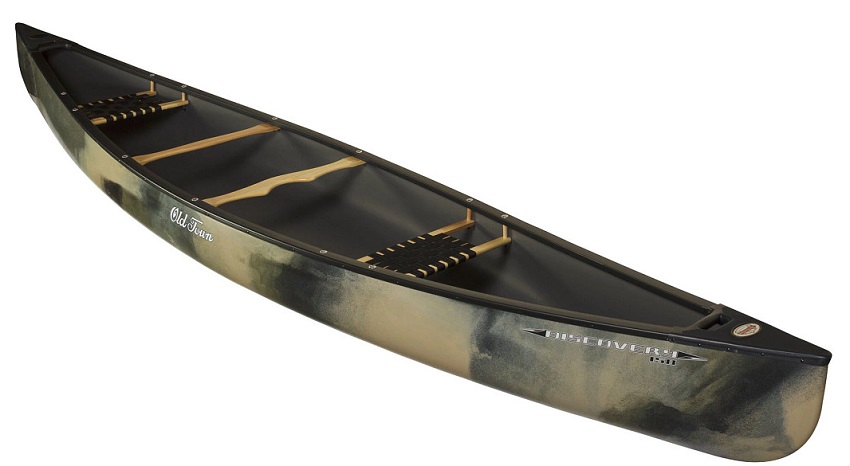
Length: 15 ft. 8 in. (4.8 m)
Width: 35.5 in. (90.2 cm)
Weight: 87 lbs. (39.5 kg)
Capacity: 1150 lbs. (521 kg)
Material: ABS Laminate
It’s not for nothing that Old Town Canoes make this list more than once. As the oldest manufacturers of canoes in the world, they know how to make a great boat. The Discover 158 has been one of their best-selling canoes for over 30 years and with its versatile design, it shows no sign of slowing down.
The hull is designed for versatility, capable of tripping for days at a time, or for an afternoon of exploring your local lake with the kids. The slightly shallower depth of the Old Town Discovery 158, compared with other models, makes it more suitable for smaller framed paddlers. This doesn’t affect the load capacity, though, which is an enormous 1150 lbs.
The Discovery 158 may not be the lightest boat on the market, but the molded carrying handles at either end make it easy to move around on the land. There is also an ash carrying yoke in the center of the canoe for solo carrying. The webbed seats are designed for comfort on the water, as well as to keep you cool and drain any water that splashes over the sides.
Pros:
- Versatile hull design
- Lower sides make it easier for smaller-framed canoeists
- High capacity
Cons:
- Not quite as versatile as the Mad River Explorer
Best Inflatable: Sea Eagle TC16
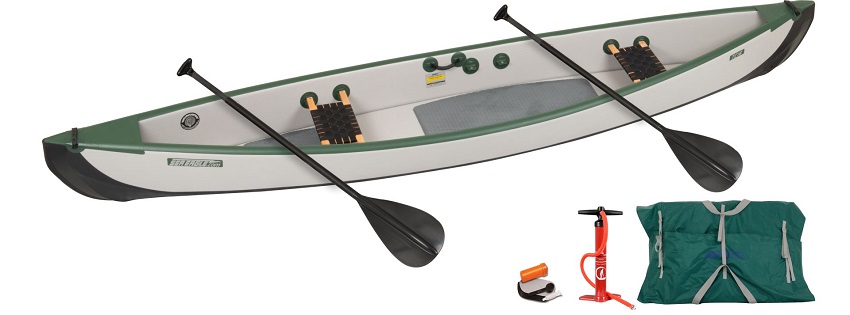
Length: 16 ft. (4.88 m)
Width: 38 in. (97 cm)
Weight: 64 lbs. (29 kg)
Capacity: 915 lbs. (415 kg)
Material: 1000 Decitex Reinforced
For those who have limited storage space, or don’t want the extra strain of loading up a canoe onto the roof of their car, inflatable canoes are often the best choice. The days of these folding under you like a pool float are now gone thanks to drop-stitch technology. The Sea Eagle TC16 uses this drop stitching throughout its seams so that you can inflate this canoe to higher pressure.
What this means for you is that you get an inflatable canoe that paddles and feels like a traditional plastic model, without the hassle of transport or storage. The extra-wide design of the TC16 makes it great for beginners, those who are nervous around water, or anglers. There is loads of space to stand and move around onboard and the grip pad on the deck keeps you steady on your feet.
Rigid plastic bands at the bow and stern of the TC16 enhance the tracking capabilities of this canoe and it carries its course well over the water. A small skeg at the rear enhances the tracking, but this canoe will still get blown around a little in stronger winds. The seats in the TC16 can be removed and moved around, with anywhere from one to three paddlers at any time.
Pros:
- High-pressure design gives this canoe a rigid feel
- Easy to transport and store
- Multiple seating positions that are easy to move
- Stable
Cons:
- Inflatable canoes are affected by the wind
- Have to remember the pump and repair kit, just in case
Best for Travel: MyCanoe Duo

Length: 14 ft. 6 in. (4.42 m)
Width: 35 in. (89 cm)
Weight: 43 lbs. (19.5 kg)
Capacity: 480 lbs. (217.7 kg)
Material: Marine-Grade Polypropylene
The MyCanoe Duo is the world’s first origami-style canoe, folding down into a suitcase-sized package. This pack can fit easily in the trunk of your car, or wardrobe, or be checked onto a flight. This is a canoe you can take around the world hassle-free.
The marine-grade polypropylene that the MyCanoe Duo is made from is rated for up to 20,000 folds, so you can put this canoe together every day for over 50 years and still not worry. Assembly takes just five minutes, too, so there’s no hanging around at the water’s edge. Once assembled, this canoe can comfortably fit two fully grown adults and their gear, or a pup, for a day on the water.
Compared with other models on this list, the MyCanoes Duo is relatively short. This, along with the flat hull shape, will limit the top speed and tracking capabilities. This is a travel canoe, or for recreational canoeists with limited space, rather than a high-performance model. That said, it’s suitable for camping trips in calm conditions.
Pros:
- Highly portable design
- Can be checked in on flights
- Easy to assemble
- Durable build
Cons:
- Highly affected by wind
- Low weight capacity
Best for Fishing: Old Town Saranac 146
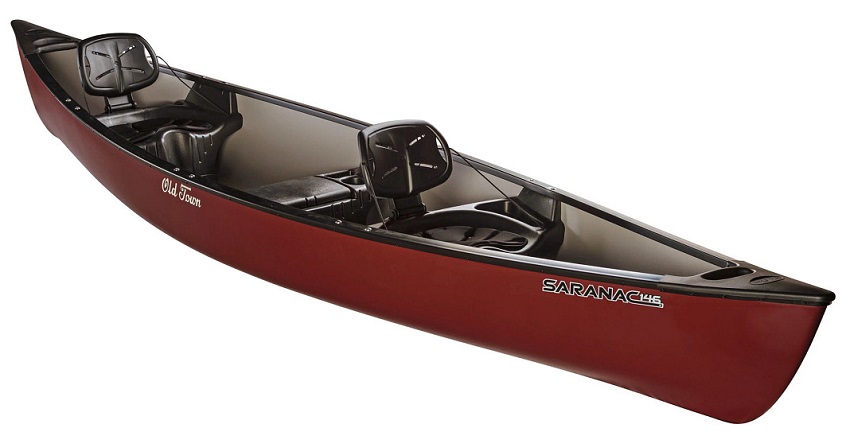
Length: 16 ft. (4.87 m)
Width: 37 in. (94 cm)
Weight: 89 lbs. (40 kg)
Capacity: 850 lbs. (385 kg)
Material: Thermoformed Polyethylene
The Old Town Saranac is another excellent canoe from the oldest manufacturer of canoes in the world. This canoe is designed for recreational-style paddling with a limited rocker profile and a channeled, flat hull, it can cover distances with ease. The flatter shape does mean that you can expect a wetter ride in choppy conditions though.
The Old Town Saranac is perhaps best designed for families and recreational canoe anglers. The extra-wide design gives this canoe excellent stability, great for those who like to stand and cast or for youngsters who can get restless on the water. Anglers will also benefit from the rod holders and paddle holders.
The seats are designed for all-day comfort, with high backrests that are fully adjustable to let you fully relax. The middle bench seat is perfect for younger paddlers but also doubles as storage.
Pros:
- Highly stable for standing to cast
- Recreational hull shape for easy paddling
- Comfortable seats and center bench seat
Cons:
- Low capacity
- Limited to recreational water
Best for Tripping: Nova Craft Prospector 16 TuffStuff

Length: 16 ft. (4.88 m)
Width: 36 in. (91.4 cm)
Weight: 56 lbs. (25.4 kg)
Capacity: 1000 lbs. (454 kg)
Material: TuffStuff Composite
Nova Craft Canoes describe its Prospector as the workhorse of the Canadian North. This canoe is designed for serious tripping in the most remote regions of the world. Whether you’re covering long distances on open water, crushing white water rapids, or portaging through swamplands, this canoe is the one you want with you.
The Prospector 16 is arguably best suited to river tripping, with its rocker profile you get a high and dry ride, even in the gnarliest rapids. The slight v-shape of the hull gives this canoe excellent secondary stability, perfect for self-righting as you navigate the river.
This canoe is more than capable on open water too, though. The 16-foot waterline tracks well in a variety of conditions, and the rocker profile lets you cruise over waves, whether battling into the wind or sailing downwind. The TuffStuff Composite material is strong enough for most trips, but if you’re heading somewhere with rough rocks and extreme portages, the TuffStuff Expedition model gives you slightly more durability.
Pros:
- Excellent versatility for tripping
- Strong enough to withstand hard use
- Light enough to portage easily
- Good capacity
Cons:
- Slight river orientation can limit open water abilities
Best Budget: Mad River Canoes Adventure 14
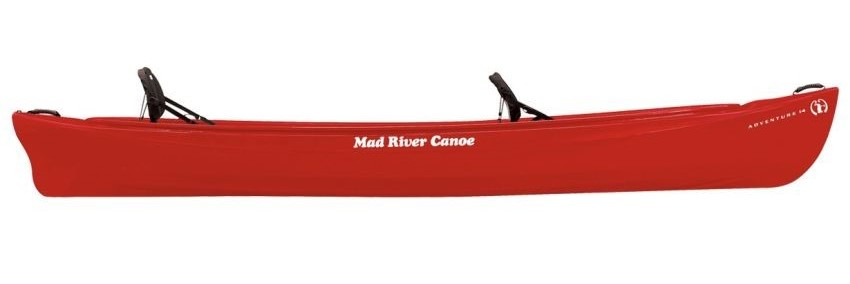
Length: 14 ft. (427 cm)
Width: 33 in. (84 cm)
Weight: 75 lbs. (34 kg)
Capacity: 875 lbs. (397 kg)
Material: Polyethylene
The Mad River Canoes Adventure 14 is the ideal canoe for families, sportsmen, or as a second canoe for visitors or family. This reasonably priced canoe features a simplistic but stable hull design which is designed around stability and ease of paddling. The molded design keeps weight low for a polyethylene canoe but retains durability and strength.
Mad River Canoes has made this a directional canoe, with a little rocker at the bow but a longer keel line at the rear. This means you can ride over waves when things get choppy, but carry speed and track with ease. The covered areas at the bow and stern also prevent waves from filling the canoe if they crash over the ends.
The molded-in seats are fitted with seat pads for added comfort, and fully adjustable backrests to keep you out on the water all day. The central seat is more simplistic, but still comfortable enough for a youngster to stay on the water all day with you. These seats are fitted with cupholders, so you can enjoy a beverage as you cruise around the lake.
Pros:
- Good budget canoe
- Simple and easy to paddle
- Comfortable seats
Cons:
- Limited technicality of the design
- Low capacity
Best Recreational: Lifetime Kodiak
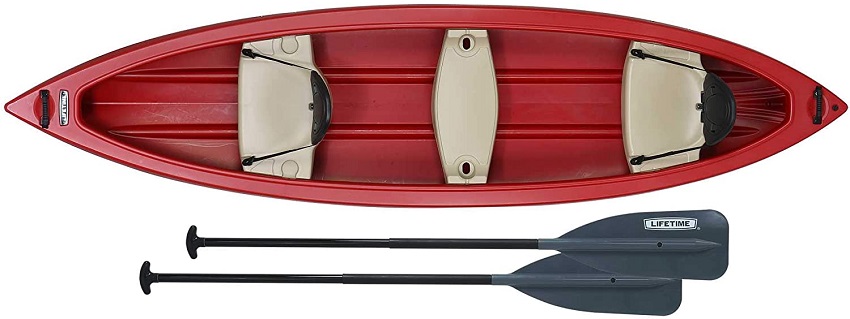
Length: 13 ft. (3.9 m)
Width: 39 in. (99 cm)
Weight: 96 lbs. (43.5 kg)
Capacity: 600 lbs. (272 kg)
Material: High-Density Polyethylene
The Lifetime Kodiak is a family-friendly recreational canoe that will withstand years of summers exploring the lake and introducing youngsters to canoeing. The Kodiak is one of the widest canoes on the market, making it stable enough to stand and move around. This suits recreational anglers, youngsters who don’t like to stay still for too long, and families with pups that love the water.
The hull of the Kodiak is designed to carry a reasonable amount of speed over the water, but at just 13 ft. long, this is never going to break any records. This shorter length does make it easier to store this canoe at home and cartop it though. Moving this canoe from the car to the water is easy with Lifetime’s wheel, fitted at the rear of the keel line.
When it comes to recreational canoeing, you want to know that you’re going to be comfortable. The Kodiak comes with three fitted seats, with those at the bow and stern fitted with adjustable backrests. These seats include molded-in cup holders and rod holders, to add to the versatility of the Kodiak.
Pros:
- Highly stable
- Wheel fitted for easy transport
- Versatile recreational canoe
Cons:
- Heavy
- Shorter waterline
Best White Water: Esquif Canyon
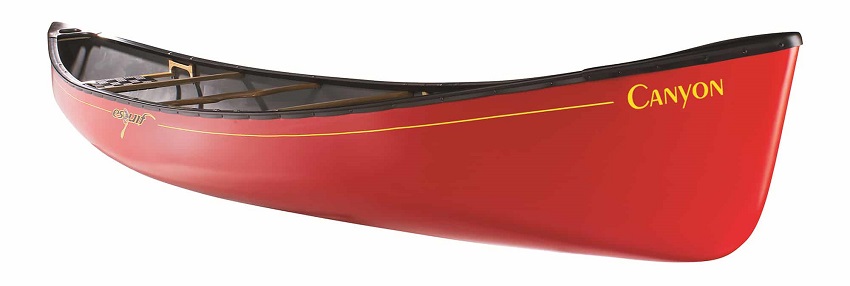
Length: 16 ft. 5 in. (5.02 m)
Width: 35 in. (88.9 cm)
Weight: 75 lbs. (34 kg)
Capacity: 1000 lbs. (455 kg)
Material: T-Formex
The Esquif Canyon is designed for white water performance as a tandem pair. This canoe is equally at home on days out, or on multi-day trips down technical, high-volume rivers. The high rocker profile couples well with the depth of the Canyon to give you a canoe that turns quickly amid rapids and keeps you dry.
Although primarily a white water canoe, the Canyon can be used on open water trips, too. It generally excels where your gear would otherwise overload a canoe with less rocker. In this instance, the curved ends prevent the Canyon from dragging in the water and allow you to maintain a good speed.
The Canyon is not the lightest canoe on the market, but at just 75 lbs., you won’t have any issue carrying it on the portage trail. Fitted carrying handles and a carrying yoke give you options when it comes to carrying. Ash thwarts are fitted throughout the Canyon for lashing gear and additional strength.
Pros:
- Strong rocker profile for white water
- High load capacity for gear hauling
- Designed for tripping
Cons:
- High rocker profile limits open water capabilities
- Pricey
Best Lightweight: Wenonah Aurora Ultralite Aramid
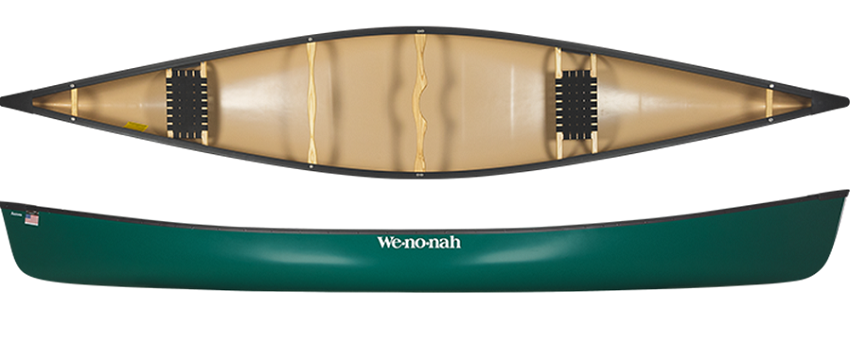
Length: 16 ft. (487 cm)
Width: 35 in. (89 cm)
Weight: 39 lbs. (17.6 kg)
Capacity: Not stated
Material: Aramid Composite
The Wenonah Aurora is designed for day-tripping or overnight gear hauling. This canoe is designed to turn quickly and easily in moving water and carry speed to easily cover long distances on lakes. Despite the sleek design of the hull, this canoe inspires stability and suits paddlers of all levels.
The Wenonah Ultralite hulls use Aramid, a material used in aerospace engineering and bulletproof armor. These canoes are tough enough to stand up against tripping and light enough to carry over the longest of portage trails. Wenonah has even added extra layers in the areas where it matters the most, to make sure you’re not wearing thin.
The stiff feeling of the Aurora Ultralite Aramid makes this canoe ideal for experienced canoeists who can make the most of the high-quality design. However, all of this engineering doesn’t come without a price tag and the Aurora is unlikely to attract the attention of beginners. Although strong and durable, you also won’t want to be leaving this canoe outside or dragging it through swamps and over rocks.
Pros:
- Ultralight aramid build
- Stiff and responsive canoe
- Designed for rivers and open water
Cons:
- Very expensive
- Doesn’t take abuse like plastic models
Best Tandem Canoes Buying Guide

Length
Length is the best place to start when deciding on the right canoe. Most tandem canoes are between 15 – 17 feet long. Shorter tandem canoes are easier to turn on the water and better suited to river canoeists, those who don’t want to carry bigger loads, or for smaller framed pairs.
The benefit of longer canoes is usually felt by those who like to cover greater distances on their days out on the water. A longer waterline helps a canoe to maintain its speed and usually equates to better tracking, too. These longer canoes usually have more onboard space than shorter models and are better suited to anglers, larger paddlers, and those who like to load up with equipment.
Width
The width, or beam width, of your canoe, is the widest point from side to side. Usually, this is between the gunwales around the center of your canoe, where the carrying yoke is situated.
Like the length, the width of your canoe impacts its speed. Wider canoes are slower because they generate more drag as you paddle. Narrower canoes are sleeker and glide better through the water, and this can also help with tracking.
Wider canoes are more stable, though. If you aren’t looking to cover long distances, but want a canoe that inspires confidence on the water or is easy to relax in, then choose a wider canoe. Wide canoes are also the choice of canoe anglers who can then stand in them to cast.
Depth
The depth of a canoe will impact how high you sit in the water and usually influences the load capacity of your canoe. This depth is also sometimes expressed as freeboard. This is the measurement from the gunwales to where the sidewalls meet the hull.
Deep canoes are best suited to calm conditions, or heavier loads. If your canoe sits deep in the water, it will drag rather than glide, and this affects top speed and maneuverability. Your stability will also be heavily compromised if your gunwales are too closed to the water.
Deep canoes can be affected by wind if they are empty. The high sides often act like sails and can be blown around more easily than canoes with a lower freeboard. If you paddle as a lightweight pair, a shallower canoe will be easier to control, but you may find you have a wetter ride on rivers.
Rocker
The rocker profile of a canoe is how much it curves from end to end. Canoes with a low amount of rocker will appear to be flatter, while those with a higher rocker profile will look more banana-shaped.
A low rocker profile is usually found on recreational canoes and some tripping canoes. A lower rocker profile lengthens the waterline of your canoe, which makes it track more efficiently through the water and carry more speed.
Canoes with higher rocker profiles are usually better suited to rivers, or mixed environment tripping. This is because the curve makes them easier to turn in tight spots and gives them an ability to ride higher over waves, giving you a drier ride. Having the bow of the canoe clear of the water limits the tracking capabilities of a canoe though.
Capacity
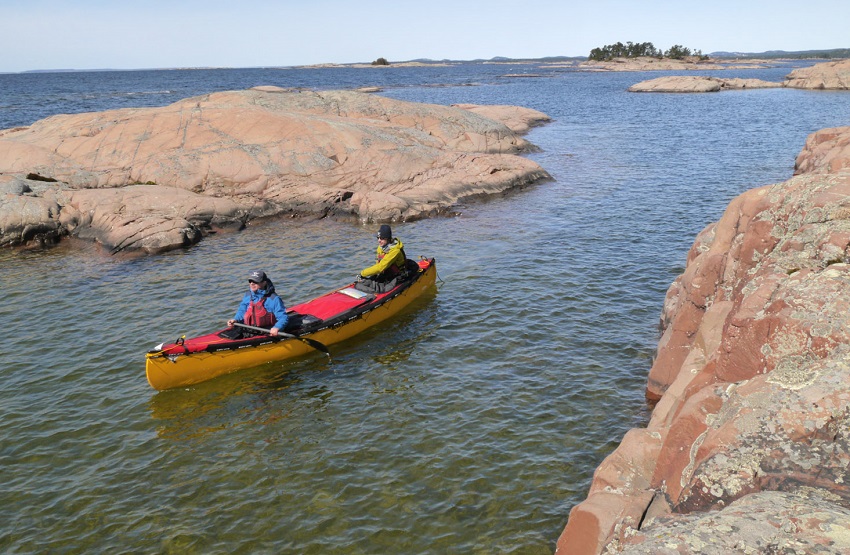
The capacity of a canoe is worked out at the point the canoe would no longer be afloat. To retain optimal performance, you should avoid overloading 70% of the capacity of your canoe. For example, if your canoe has a capacity of 450 lbs., you should keep your weight under 315 lbs.
Your paddling weight includes more than just your bodyweight. On top of that, you should include all of your worn equipment and any extra gear you plan to haul with you. If you’re heading out tripping or angling, your gear can easily weigh almost as much as you and you can quickly find yourself overloading a canoe.
RELATED: Canoe Accessories: Must-Have Gear for Your Next Canoeing Trip
Before you buy your tandem canoe, consider who you will be paddling with and what you will be carrying with you. Capacity is useful if you haul gear or pets with you, but with capacity comes extra size. Larger canoes can be hard to control in wind and if you don’t need the extra capacity, you will find a smaller canoe easier to paddle.
Seating

Tandem canoes tend to come with just two seats. Some models, however, come with a third seat which allows you to carry an extra passenger, or with seats that can be removed and moved around the canoe. This makes your tandem canoe more versatile for extra passengers, or for paddlers who like to paddle solo periodically.
Most seats in tandem canoes are molded plastic or wooden thwarts laced with webbing straps. More advanced seating systems might be more comfortable, but they also come with the associated weight. If you kneel in your canoe for extra stability on rivers, make sure your feet fit under the seats and aren’t going to get stuck if you need to exit in a hurry.
Weight
You need to be able to move your canoe around both on and off the water. You’ll have the help of your tandem partner, but if you’re both smaller framed, you may struggle to move around a canoe that weighs upwards of 90 lbs.
Moving your canoe around off the water involves loading it up onto the roof of your car or into your truck bed. If you’re going tripping, you may have portages that are far longer than the distance from the parking lot to the lake. These portages can be over rough ground and rocky terrain.
Lightweight canoes do have their drawbacks though. They tend to come with a higher price tag but are also generally not as durable as heavier canoes. If you’re happy to move the weight around, you will find that a heavier canoe will outlast most lightweight models without any maintenance to keep them going.
Materials
Modern canoes are generally made from rotomolded plastics, ABS laminated plastics, or composite materials.
Rotomolded plastic canoes tend to be the cheapest option and some of the most hardwearing, but also the heaviest. ABS laminated plastics are stiffer than rotomolded plastics and have the bonus of being less affected by UV damage. ABS canoes are usually more expensive than rotomolded plastics but can outlast them.
Composite canoes use fiberglass to keep the weight of the canoe lower and improve the stiffness. These canoes are among the most expensive but if you need a lightweight canoe, nothing else comes close. Composite canoes lack the strength of plastic canoes and are less suited to rivers and rough environments, but are great for long trips with lots of portages.
Intended Use
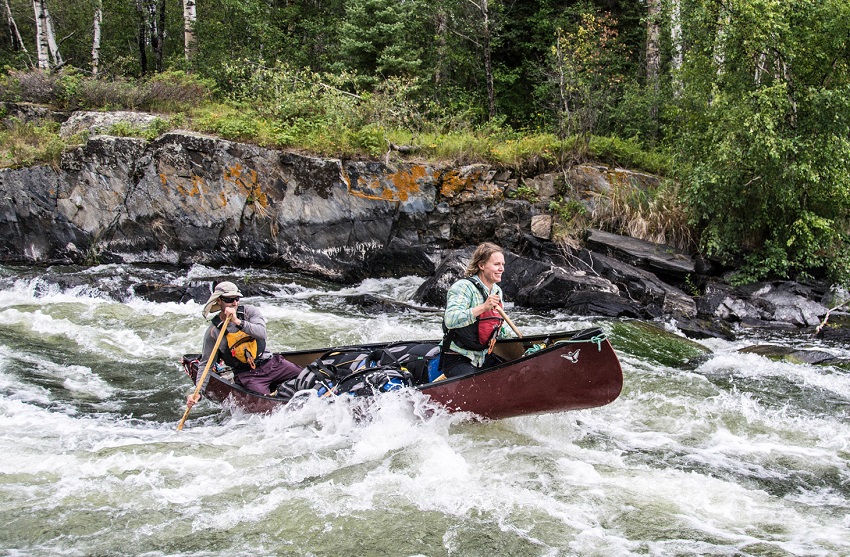
The right canoe for you depends on where you want to go canoeing. If you always paddle in the same environment, picking a canoe can be straightforward. However, if you regularly change between calm water, rivers, or tripping, you will need to find a canoe that fits all of these categories.
There are canoes with specific features, too. Angling canoes often come with specific storage, as well as rod holders so you can trawl as you paddle. White water or tripping canoes are often minimalist, to keep the weight down, while recreational canoes may have extra features like seats that double as coolers.

